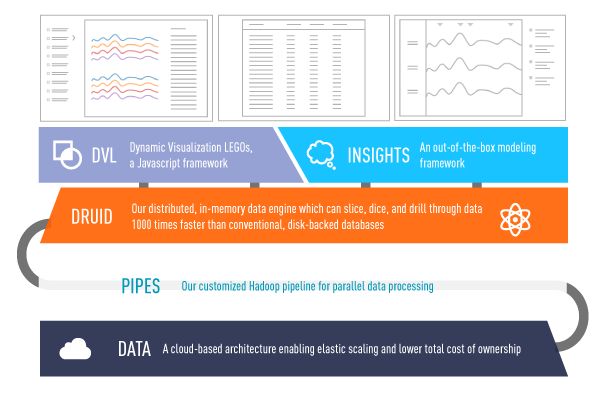
Druid Summons Strength in Real-Time
This has indeed been the year of Hadoop as the most appropriate synonym for big data, but according to some who hover on the fringes of that ecosystem (and even some who are in the middle of it), a lot of the tech behind it has been fetishized to the point of not being useful or comprehensible to actual business users.
 From the Hortonworks exec who told us that many businesses are confused about where Hadoop belongs in their enterprise strategy, to Mike Driscoll, CEO of Metamarkets, who told us this week that there is no compelling message or context for enterprise technology folks, the next big thing for big data might simply be a long string of ease of use (versus further complicated functionality) for technology executives.
From the Hortonworks exec who told us that many businesses are confused about where Hadoop belongs in their enterprise strategy, to Mike Driscoll, CEO of Metamarkets, who told us this week that there is no compelling message or context for enterprise technology folks, the next big thing for big data might simply be a long string of ease of use (versus further complicated functionality) for technology executives.
At the heart of some of this usability with added capability or performance goal sits the almighty cloud. By wicking away the hardware headache and management hassles, companies like Driscoll’s can add features that might boost speed without requiring a bevy of new hires.
Metamarkets focuses distinctly on what it calls “web-scale” companies, which for their business tends to include a number of large-scale digital publishing companies, including Financial Times as well as several higher-end online advertising platform vendors.
In an effort to expand their “real-time” capabilities, the company architected a streaming data store component to its cloud-delivered analytics platform called Druid, which was recently set free to spread its wings in the open source community. This data store, which was named after a shape-shifting comic character, could address some of the challenges of traditional database approaches—or at the very least provide the open source community with something new to chew on.
On that note, it’s important to define what’s really meant by real-time here. For an area like high-frequency trading, for instance, no amount of fiddling with Druid could make it battle-ready. However, since Driscoll defines real-time as less than a thousand milliseconds (via cloud delivery even), he claims for most use cases in their bread and butter kitchen (ad platforms) this is certainly fast enough.
The company says that for the primary markets it serves, namely large-scale web publishing and digital advertising, the stack it’s built to run on (large non-tricked-out Amazon EC2 instance types) already leverages a number of open source projects for processing, querying and visualizing high volume streaming data. However, as Driscoll described for us, Druid offered up something they weren’t able to find elsewhere—the ability to stream data via an in-memory approach using a column-based data store for lower latency query response times.
Metamarkets’ pitch with Druid is that Hadoop is not the cure-all to big data woes. He says that while it’s an excellent approach for massive data, the time it takes to chew through queries is too long. When asked about how this might be solved with other approaches, including Impala, the new “real time” Hadoop system developed by Cloudera, he said that is great for making queries fast but misses the mark when it comes to interactivity of data.
As Driscoll put it, a real-time Hadoop tool like Impala can address the speed concerns around issuing a query to a Hadoop system, but that’s only one aspect of what is important to companies who are actually going to make use of a faster, more efficient Hadoop. “Speed is just one part of it; you can launch all kinds of MapReduce processes, and while the response might be fast, the matter of latency between when an event happens and when you know about it is the second critical component there.”
Part of what makes Druid noteworthy is that as events come into the Metamarkets open source data store, they are immediately accessible for querying. Therefore, as Driscoll describes, “anything that has a Hadoop-backed architecture can always have something built on top like a caching layer, but unless it’s integrated into the overall architecture, it’s hard to get any real-time visibility into your data.”
On the surface, Druid looks like a standard MPP database, like a Vertica or Netezza, but the key difference is that it’s been architected from scratch to fit within a cloud context. On the other side, it behaves somewhat similarly to Hadoop with data sharding across many nodes, partitioning and parallel performance boosts, not to mention a similar fault tolerance mechanism that offers double-replication of data (whereas Hadoop offers triple). The secondary value prop is the in-memory component, which Driscoll says offers a 1,000x performance increase over traditional database approaches like Vertica, Netezza, Greenplum and even the much-heralded Dremel (not far removed from Impala).
When it comes to Dremel, for example, Driscoll says the differentiation is in the fact that Dremel and others are still disk-bound where read speeds are about 1,000x lower than when reading off DRAM. “In-memory databases have a massive performance advantage over traditional disk-backed databases, so they are a key component of Druid,” he said.

In addition to the aspects of Druid he mentioned, the concept of rolling restarts might be a worthwhile capability for some users who don’t want to have to restart the database with the addition of new code, since it’s possible to bring nodes down one at a time then back up again in a rolling fashion.
“We started to see a clear need in the Hadoop ecosystem for something that could be real-time and fast at scale,” said Driscoll. “Besides, we believed strongly in having an open source component since the era of licensed software is coming to a close—the future belongs to cloud-backed SaaS.” The Metamarkets CEO went on to tell us that the real-world customers they deal with don’t want to think about Hadoop, databases or the underlying stack – all they want is results. Thus, being able to deliver the entire stack with reliability built in as well as the complexity of Hadoop and on-site hardware removed is valuable. He claims that since they open-sourced Druid in mid-October there have been hundreds of GitHub downloads and over 20 forks to the database built.
All the open source interest in the world is useless without an actual use case, but when it comes to users of Druid, the company was quick to point to Netflix as proof of scale. Driscoll told us that the video giant got wind of the open source data store and was granted an early look at the architecture and tested the offering.
The point is that it is able to scale. Metamarkets looks at over a trillion events processed on its platform on a daily basis and between 10-20 billion events per day. He said that overall, in a market like online advertising, there are around 100 billion micro-transactions per day across the vendors who cater to this high-volume, high-speed and quickly growing segment. Therefore, it’s not surprising that some of the core innovation in big data technology is coming from the areas of online ad markets. Their message of usability and performance, however, can be easy to lose since their core customer base is so targeted and they don’t tend to pitch heavily to further verticals, even if they see applicability in emerging areas.
We talked briefly about how online advertising big data needs are driving innovation that can be carried over to other industries like insurance, healthcare, smart grids and other areas. His thought on this mesh was noteworthy, if not somewhat epic…
“What we’re witnessing in the world of digital advertising is the birth of a global digital nervous system. The same kind of wiring that helps it work can easily extend to other verticals…the tech emerging here will lead the next generation of tech for other industries.”
Related Articles
Six Super-Scale Hadoop Deployments
Cloudera CTO Reflects on Hadoop Underpinnings
Expedia Adds Notes to Big Data Symphony
April 25, 2025
- Denodo Supports Real-Time Data Integration for Hospital Sant Joan de Déu Barcelona
- Redwood Expands Automation Platform with Introduction of Redwood Insights
- Datatonic Announces Acquisition of Syntio to Expand Global Services and Delivery Capabilities
April 24, 2025
- Dataiku Expands Platform with Tools to Build, Govern, and Monitor AI Agents at Scale
- Indicium Launches IndiMesh to Streamline Enterprise AI and Data Systems
- StorONE and Phison Unveil Storage Platform Designed for LLM Training and AI Workflows
- Dataminr Raises $100M to Accelerate Global Push for Real-Time AI Intelligence
- Elastic Announces General Availability of Elastic Cloud Serverless on Google Cloud Marketplace
- CNCF Announces Schedule for OpenTelemetry Community Day
- Thoughtworks Signs Global Strategic Collaboration Agreement with AWS
April 23, 2025
- Metomic Introduces AI Data Protection Solution Amid Rising Concerns Over Sensitive Data Exposure in AI Tools
- Astronomer Unveils Apache Airflow 3 to Power AI and Real-Time Data Workflows
- CNCF Announces OpenObservabilityCon North America
- Domino Wins $16.5M DOD Award to Power Navy AI Infrastructure for Mine Detection
- Endor Labs Raises $93M to Expand AI-Powered AppSec Platform
- Ocient Announces Close of Series B Extension Financing to Accelerate Solutions for Complex Data and AI Workloads
April 22, 2025
- O’Reilly Launches AI Codecon, New Virtual Conference Series on the Future of AI-Enabled Development
- Qlik Powers Alpha Auto Group’s Global Growth with Automotive-Focused Analytics
- Docker Extends AI Momentum with MCP Tools Built for Developers
- John Snow Labs Unveils End-to-End HCC Coding Solution at Healthcare NLP Summit
- PayPal Feeds the DL Beast with Huge Vault of Fraud Data
- Will Model Context Protocol (MCP) Become the Standard for Agentic AI?
- OpenTelemetry Is Too Complicated, VictoriaMetrics Says
- Thriving in the Second Wave of Big Data Modernization
- Google Cloud Preps for Agentic AI Era with ‘Ironwood’ TPU, New Models and Software
- Google Cloud Fleshes Out its Databases at Next 2025, with an Eye to AI
- Can We Learn to Live with AI Hallucinations?
- Monte Carlo Brings AI Agents Into the Data Observability Fold
- AI Today and Tomorrow Series #3: HPC and AI—When Worlds Converge/Collide
- The Active Data Architecture Era Is Here, Dresner Says
- More Features…
- Google Cloud Cranks Up the Analytics at Next 2025
- New Intel CEO Lip-Bu Tan Promises Return to Engineering Innovation in Major Address
- AI One Emerges from Stealth to “End the Data Lake Era”
- SnapLogic Connects the Dots Between Agents, APIs, and Work AI
- Snowflake Bolsters Support for Apache Iceberg Tables
- GigaOM Report Highlights Top Performers in Unstructured Data Management for 2025
- Supabase’s $200M Raise Signals Big Ambitions
- Big Data Career Notes for March 2025
- GenAI Investments Accelerating, IDC and Gartner Say
- Dremio Speeds AI and BI Workloads with Spring Lakehouse Release
- More News In Brief…
- Gartner Predicts 40% of Generative AI Solutions Will Be Multimodal By 2027
- MinIO: Introducing Model Context Protocol Server for MinIO AIStor
- Dataiku Achieves AWS Generative AI Competency
- AMD Powers New Google Cloud C4D and H4D VMs with 5th Gen EPYC CPUs
- CData Launches Microsoft Fabric Integration Accelerator
- MLCommons Releases New MLPerf Inference v5.0 Benchmark Results
- Opsera Raises $20M to Expand AI-Driven DevOps Platform
- GitLab Announces the General Availability of GitLab Duo with Amazon Q
- Seagate Unveils IronWolf Pro 24TB Hard Drive for SMBs and Enterprises
- Intel and IBM Announce Availability of Intel Gaudi 3 AI Accelerators on IBM Cloud
- More This Just In…



























